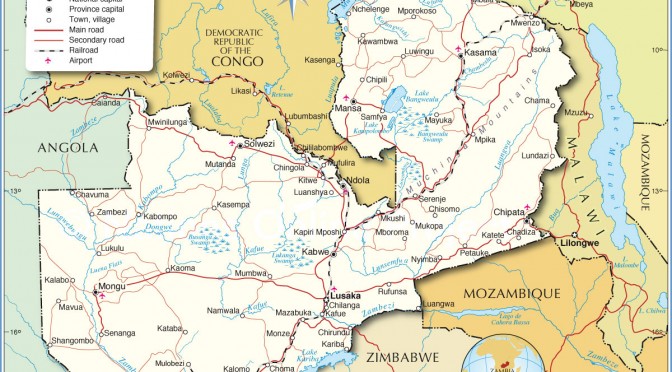Zambia and Zimbabwe, two southern African countries heavily reliant on Lake Kariba for power generation, are facing extended daily power cuts of 12 to 18 hours due to dropping water levels caused by climate change. The two countries are predominantly dependent on hydropower on Kariba – the world’s largest man-made lake on their shared border along the Zambezi River – but erratic rains and increased heat over the past few years have caused the lake’s water levels to drop to record lows, drastically reducing the power generation capacities of Zambia and Zimbabwe.
Since 2020, the southern African region has not received reliable rainfall. Combined with increased evaporation due to higher temperatures, this has caused Lake Kariba to fall to its current precarious levels.
Lake down to 11% usable storage
According to the Zambezi River Authority (ZRA), a bi-national body mandated with regulating the shared lake, Kariba’s live storage (water available for power generation) had fallen from its design capacity of 13 meters to just 1.73 meters as of July 09, 2024. This represents 11,90% of the reservoir’s usable storage compared to last year’s level of 31,16%. Lake Kariba is designed to operate between levels 475.5 meters and 488.5 m (with 0.7 m freeboard) for hydropower generation.
“The Lake level is steadily decreasing due to low inflow, closing the period under review at 477.22m (11.90% usable storage) on July 9th 2024, compared to 479.91m (31.16% usable storage) recorded on the same date last year,” the authority said in its weekly report.
The Zambia Electricity Supply Corporation (ZESCO) and the Zimbabwe Power Company (ZPC) operate power plants on the north and south banks of Lake Kariba respectively. The Zambian plant has an installed capacity of 1080 megawatts (MW), while the Zimbabwean plant has a capacity of 1050 MW. However, due to the drastically reduced water levels on the lake, power generation on the Zambian side has fallen to just 98 MW while that on the Zimbabwean side has fallen to 214 MW.
With the rains still some five months away, there are genuine concerns about the possibility of the two hydro plants being shut down. The lake reached its lowest level of 475.60 meters (about 0.8% usable storage or 10 cm above the Minimum Operating Level) on December 30, 2022.
‘We’ve lost 800 MW’
“The installed capacity at Kariba is 1,050 megawatts, but due to water rationing caused by low inflows in the lake, we are currently only able to produce an average of 214 megawatts,” Zimbabwe’s Energy minister Edgar Moyo told the Parliament at the end of June.
“On that perspective, after losing over 800 megawatts, it makes it very difficult to sufficiently supply power in the country,” Moyo said.
Zimbabwe’s peak electricity demand is about 2,200 megawatts while supply stands at 1,206 MW, with the bulk of this power now coming from its thermal-fired power station in Hwange, according to data posted on ZPC’s website.
Zambia has installed a power generation capacity of 3,356.6 MW; 83% of this is hydro and increasingly vulnerable to climate change; 9% is coal; 5% is heavy fuel oil; and 3% is solar photovoltaic. On June 30, ZESCO warned Zambians to brace for longer power outages beyond the current 12-hour daily rationing as it is struggling to generate enough power.
The drought conditions have similarly affected power generation at ZESCO’s three other hydro stations, namely Kafue Gorge (producing 372 MW against an installed capacity of 990MWs); Lower Kafue Gorge giving 179 MW against an installed capacity of 750 MW; and Itezhi-Tezhi Power Company delivering only 34 MW against an installed capacity of 120 MW.
A turn to solar
This has prompted the two neighbors to speed up the move toward solar power.
In January last year, Zambia signed a $2 billion solar deal with United Arab Emirates renewable energy company Masdar for the development of 2,000 MW solar projects.
In April this year, ZESCO entered into a power purchase agreement (PPA) with SkyPower Global, a Canadian-based independent power producer for the supply of 1,000 MW of solar energy to about 4 million Zambia households.
Also, in April, Zambia’s President Hakainde Hichilema commissioned a 60 MW Copperbelt Energy Corporation (CEC) Itimpi Solar Plant in the country’s second city of Kitwe. Last year, the company commissioned 34 MW of solar energy in Riverside, also Kitwe, bringing the total solar energy capacity created by CEC to 94 MW.
In March 2019, a joint French (Neoen)-American (First Solar) consortium commissioned Zambia’s first utility-scale solar project, a 47.5 MW plant providing power into ZESCO’s national grid.
Italian firm Enel commissioned the second Scaling Solar project in May 2020, providing 26 MW of solar power to the grid.
On its part, Zimbabwe is working with China Energy Engineering Corporation for the development of a 1,000 MW floating solar plant on its side of Lake Kariba.
Another 500 MW plant is planned for the resort city of Victoria Falls. Finance Minister Mthuli Ncube has agreed to guarantee viable power tariffs to solar projects by 27 other small independent power producers. The developers are set to build 997.9 MW of capacity, with a total investment of around $1 billion. In order to encourage solar uptake, in 2019 the government of Zimbabwe removed import duty on all solar products.
Solar saved South Africa
Solar power saved South Africa, the African continent’s biggest economy, from the brink. Thanks to the boom in solar power, in early July South Africa marked 100 days without any power cuts, the first time since 2020. This turnaround has been attributed to the massive adaptation of solar power both as industrial and household levels, with the country adding an average of 3,000 MW of solar power annually over the past three years.
Zambia and Zimbabwe enjoy long and intense hours of sunlight to support solar energy generation, averaging about 2,500 hours of sunshine per year.
Cyril Zenda Source: Al Mayadeen English


